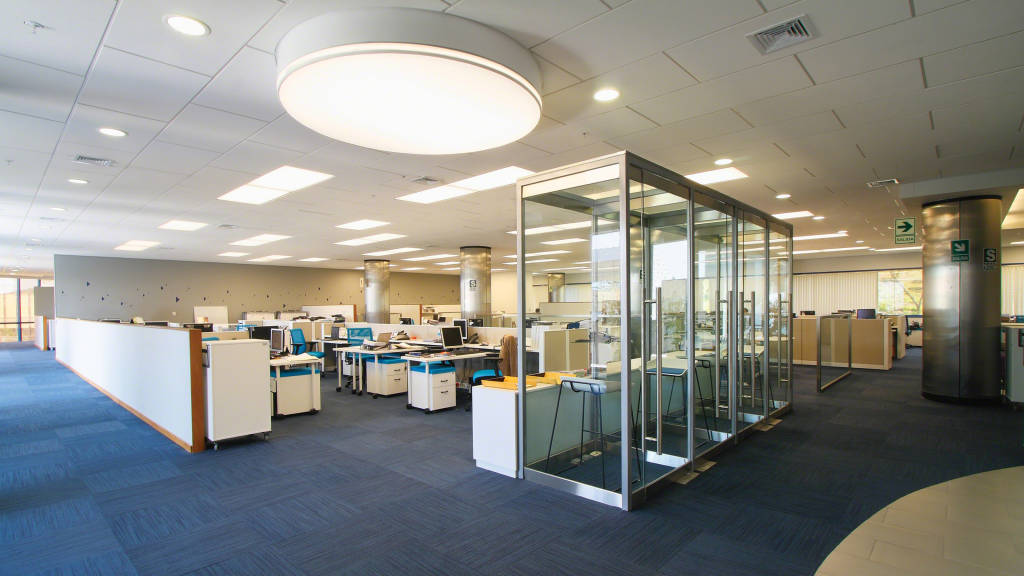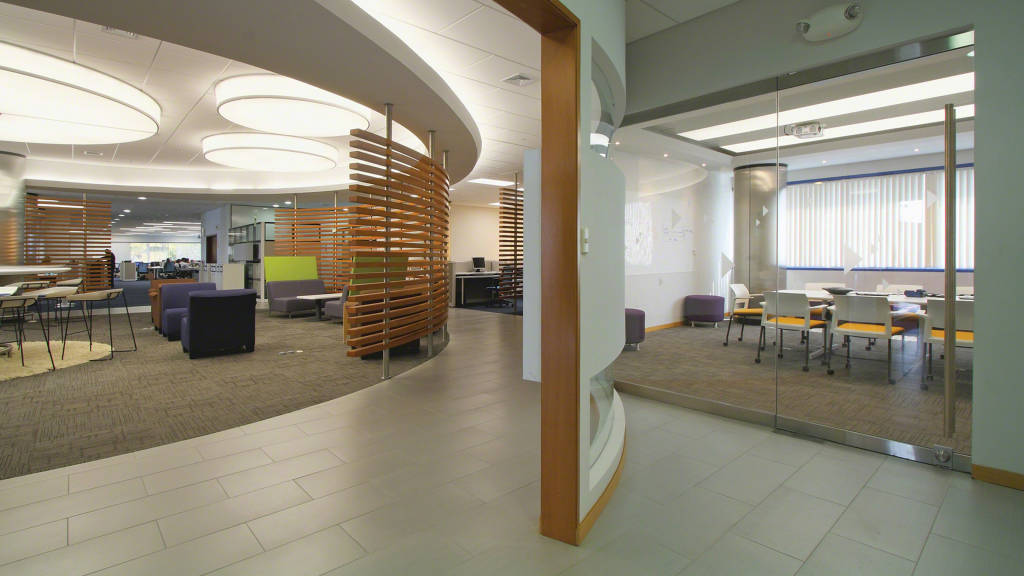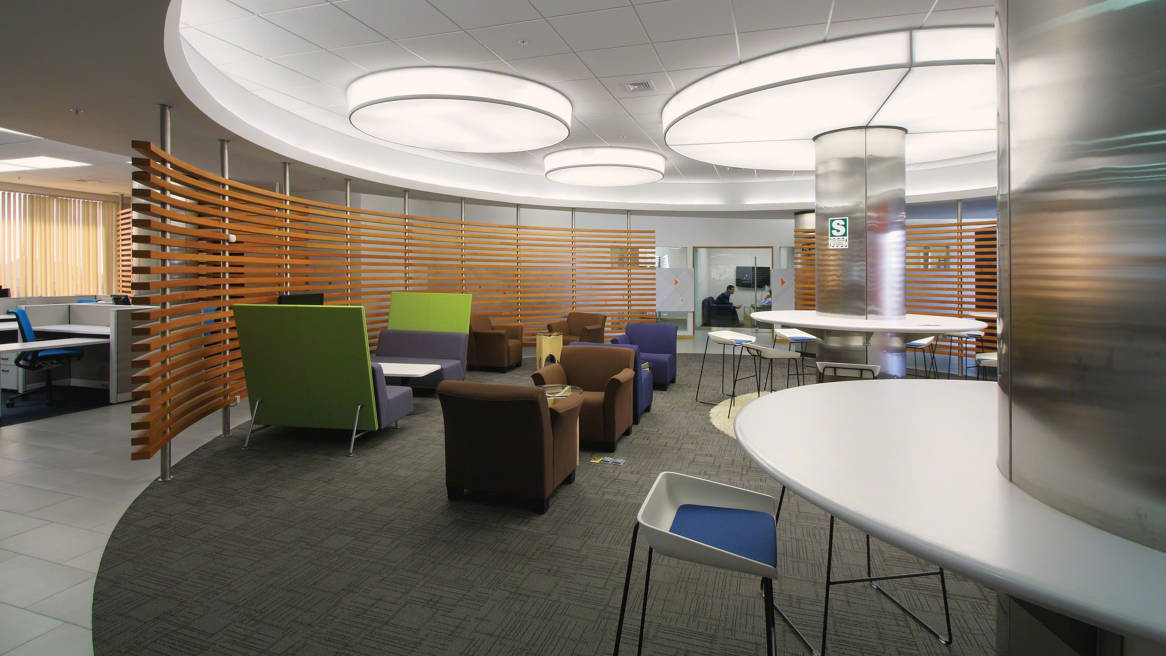Banco de Crédito del Perú Redefines Culture
Banco de Crédito del Perú is the largest and oldest bank in Peru, a model of performance in the banking industry, highly regarded for steady growth and innovative financial products.
A new workplace helps redefine a bank’s culture
Banco de Crédito del Perú is the largest and oldest bank in Peru, a model of performance in the banking industry, highly regarded for steady growth, innovative financial products, and a growing market share in the rapidly expanding Peruvian economy. But the bank’s real estate assets, and by extension its work processes and organizational culture, were not keeping pace. Its 1980s era headquarters campus preceded many of the work processes and technologies in use today. Employee ergonomics and well-being (barely on the radar decades ago), and staff productivity also were becoming concerns.
“We needed to change our organizational culture, flatten the organization and increase collaboration and teamwork. We wanted to use real estate to lead these changes and at the same time make better use of that asset,” says José Ignacio Maúrtua, director, centralized administration. “We needed a new overall workplace strategy, one we could use across the organization.”
The bank, known as BCP, engaged Steelcase Applied Research & Consulting (ARC), the global work and workplace consultancy, to work with the bank and their architecture firm, Metropolis Arquitectura, to develop the workplace strategy. As part of the project, ARC would help develop and pilot workplace solutions, apply the workplace strategy to individual workplaces, provide training and transition management, and develop a strategy for measuring the work environment’s effect on business results.
Successful organizations know that past accomplishments don’t ensure future success. They understand that the past is merely prologue, so they continually evaluate and renew themselves.
Engaging the organization
The ARC team began working with leadership to identify the level of organizational change needed —and how much change the company could handle. As the chart (next page) indicates, leadership saw the need for the greatest changes in work processes and space, with less significant changes needed in other areas. Next, the ARC team studied the BCP organization to gauge its readiness for change and how to best implement breakthrough changes.
ARC’s study extended beyond the executive suite. “We engaged with the users at all levels of the company,” says Izabel Barros, PhD, ARC senior consultant for Latin America based in Rio de Janeiro, Brazil, and leader of the BCP engagement team. ARC’s four-step process—ask, observe, experience, realize—reveals hidden organizational needs and ultimately leads to better solutions.
“We develop a holistic view of the company that includes a deep understanding of work processes and workers. Based on this understanding, we develop insights that help the company improve organizational performance by better leveraging people, process, technology and space.”
Another reason for working closely with BCP staff: to enlist them in envisioning their future work environment, making them part of the team that plans and implements the transition to a new workplace.
“Together we developed a new vocabulary that we used to talk about the new workplace strategy and work environments. This vocabulary was very helpful because it made it easier for everyone to understand what we needed, what the plan was, and how the organization was changing,” says Maúrtua.

The ARC/architecture partnership
ARC and BCP’s architecture firm, Metropolis Arquitectura, Lima, Peru, formed a dynamic partnership. “Our intent is to always work closely with the client’s design firm,” says Barros. “Metropolis is one of the most forward thinking architectural firms, and well known for their work in both South and North America. Steelcase has an international footprint as well. By working together, we multiply the benefits for the client.”
A three-day design charrette exemplifies this partnership. In a roll-up-your-sleeves work session in Grand Rapids, Michigan, four executives from the bank, José Orrego, principal of Metropolis Arquitectura, several ARC team members, as well as Steelcase researchers and applications experts, engaged in an intense exploration and development workshop.
“With everyone working together, we made the creative process visible for the client and demonstrated how workplace solutions link directly to their overall strategy. When everyone works together like that, the feedback is immediate. You can make revisions, fine tune plans, and make decisions much faster,” says Barros.
“One goal at BCP was to reduce the occupa- tion ratio without neglecting the quality of the office environment, and that’s a real challenge. But everything fell in place faster than I anticipated. The vocabulary we developed made it easy to communicate the intent of each part of the solution,” says Orrego.
“I especially appreciated ARC handling more of the business side, the strategic side of the project, so we could focus on the creative side, the design.”
“The path that the ARC team developed and that everyone at the bank had a hand in creating, allowed the architect to focus on design,” says Maúrtua. “The whole process was a great team effort.”
“ARC handling the business side allowed us to focus on the creative side, the design.”
José Orrego Principal, Metropolis Arquitectura
An inspired workplace strategy…
Developing the BCP workplace strategy was a journey, the destination made clearer with each step. ARC’s study of the organization, workshops with management and staff, and co-design exercises led by ARC team members led to the development of pattern maps —graphic representations of space concepts that expressed the design concept for the project.
“Patterns maps are an inventory of required types of spaces. They don’t show the size or mix of spaces but rather the relationships between settings and main paths into the work environment, interaction patterns, transitional spaces, and other workplace concepts that help everyone visualize and understand the space before they start thinking about furniture, tools, technology, etc.,” says Barros.
From here, design principles and attributes were developed to support the company’s need to increase communication and collaboration, and other goals. A menu of settings was conceived, from private to public, along with planning considerations (“Use common needs, e.g. food, shared technology, etc., to encourage spontaneous interaction among isolated groups.”).
BCP’s workplace strategy was purposely crafted to apply to all corporate offices and branches and to optimize design solutions. Involving users in the development process ensured faster buy-in by employees.
…informs an innovative workplace
The user experience is clearly defined in each work space. For example, a private team pod is described in the plan as a space where people feel comfortable and safe communicating informally. Users respect the established protocols to ensure that privacy or confidentiality is maintained. Protocols to display teams’ work encourage giving and receiving feedback and collaboration.
“BCP’s workplace strategy links business goals with the work environment and thus helps the company achieve its strategic goals, allows the architect to express his design vision, and ensures that engaged users anticipate the new work environment,” says Barros.
Pilot spaces in two areas of the headquarters building, developed by BCP, Metropolis Arquitectura, and ARC during the Grand Rapids design charrette, became workplace prototypes that were tested by users for several months. Their feedback helped refine the work environment even as final workspaces where being designed.

“What ARE We Really Doing Here?”
Jose Ignacio Maúrtua remembers exactly when BCP leadership realized that the workplace could be a strategic asset. “During our first meeting with leadership, a top manager said to me, ‘Are we trying to modify how and where we work, or are we talking about furniture? This is a much deeper conversation than I expected.’
“That was good to hear. Management came in thinking we would discuss tables and desks, the physical aspects of the environment. But the ARC process was much deeper. It was about how we can use space to promote the kind of culture our company wanted to achieve.”
Each ARC engagement uses a four-step process to address each client’s unique needs. It’s research-driven, founded on techniques pioneered by IDEO and adapted for the work environment, including cultural anthropology and ethnographic techniques. User engagement at every level of the organization includes probing questions, work process observation, and guiding users through experiences that reveal hidden needs and create better solutions. It’s a comprehensive approach that considers all four drivers of organizational performance: people, process, technology, and space.
Management thought we would discuss the physical environment. But the ARC process was much deeper: how to use space to promote culture.
A culture transformed
Involving their workers in the planning and design process helped BCP create a new work environment in support of its critical success factors, but an organizational change of this magnitude was never taken for granted.
An ARC-led transition management workshop helped create specific communications and change management plans for each new work environment and engage all stakeholders affected by the change.
An important tool in the transition plan was a workplace protocol brochure that addresses a variety of work environment issues, emphasizing how to make the most of the different workspaces now available to the staff, and policies and procedures about meeting room etiquette, shared workspace protocols, how to use private enclaves, and more.
Prior to opening the new work environment, a measurement strategy was developed to assess the impact of BCP’s work environment changes on the staff and on business performance.
The tool is a balanced scorecard, a way to measure and report on four dimensions: financial measures, business processes, customer and stakeholder perceptions, and learning and sustainability issues.
Measuring bisiness benefits
Balanced scorecard results from the pilot workplace show significant improvements across the board (see charts next page). To begin with, the work environment accommodates 140% more people in the same amount of real estate as the previous office.
Follow-up research conducted by Hay Group, the global management consulting firm, shows a 3% improvement in decision making and the quality of communication, and an overall increase of 18.3% in worker satisfaction with the new environment. Such results demonstrated the effectiveness of the new work strategy and gave the bank confidence in implementing it on a broader scale.
Following the pilot project, BCP’s first completed work environment based on the new strategy was the Cronos office in Lima. At 6,700 square meters (72,000 sq. ft.), the office accommodates 40% more people in a floor plan that uses 23% less space than the previous bank standard. With this more efficient workplace, specifically tailored to the bank’s work processes, research shows productivity gains could surpass 14%.
Critical success factor measures are up, and the first building based on the new workplace strategy supports 40% more people—in 23% less space.
Other balanced scorecard results improved, too. For example, worker perception of the bank’s image increased by 4.1%, and overall satisfaction with the workplace increased 16.7%.
In addition, important issues such as balancing privacy, making work visible, managing connections, supporting diverse workstyles, and offering inspiring spaces, all show healthy improvements.
Management now sees the organizational culture change they had hoped and planned for. “We’ve been trying to change the culture of the company for four years. Now we are a new bank. People are more willing and better able to work in teams. We’re making the organization flatter, and we’re more successful in keeping great people at the bank,” says Maúrtua. “We’re very pleased with the balanced scorecard results, obviously. The results are very good. But when we talk to people, they’re very happy. And that’s my best survey. “Moreover, we’ve learned the value of a robust and flexible strategy that we can use in all future projects. It’s changed the way we think about space: real estate has become a very strategic asset for BCP.”
“We’ve been trying to change the culture of the company for four years. Now we are a new bank.”
José Ignacio MaúrtuaDirector, Centralized Administration
Applied Research + Consulting Services
Leadership interviews
Leadership and staff workshops
Design strategy development
Workplace pilot
Evaluation tool
Change management: transition management workshop, post occupancy workplace survey


